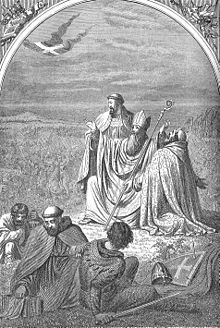Danish national flag Dannebrog fell from the sky during Battle of Lyndanisse
The Battle of Lindanise was a battle which helped King Valdemar II of Denmark establish the territory of Danish Estonia during the Northern Crusades, which were undertaken in response to calls from the Pope. Valdemar II defeated the Estonians at Lindanise (Estonian: Lindanise, today Tallinn).
Valdemar II, along with Archbishop Anders Sunesen of Lund, Bishop Theoderich von Treyden, and his vassals Count Albert of Nordalbingia and Witslaw I of Rügen, sailed to the northern Estonian province of Revalia at the beginning of June. The crusading army camped at Lindanise and built a castle there, named Castrum Danorum, which the Estonians called Taani-linn (later Tallinn), meaning Danish castle. The Estonians sent several negotiators, but they were only playing for time as they assembled an army large enough to fight the Danes.
On 15 June 1219, the Estonians attacked the Danes near the castle, right after suppertime. They advanced from five different directions and completely surprised the crusaders, who fled in all directions. Bishop Theoderich von Treyden was killed by the Estonians, who thought he was the king. The Danes were saved by their Wendish vassals, as Witslaw led a quick counterattack which stopped the Estonian advance. This gave the crusaders time to regroup, and the Estonians were routed.
Dannebrog
 Archbishop Anders Sunesen at the Battle of Lindanise
Archbishop Anders Sunesen at the Battle of Lindanise
Tradition has maintained that the flag appeared at the battle of Lindanise on 15 June 1219.[2] Legend holds that during the battle, in the Danes' hour of need, the Danish flag, the Dannebrog, fell from the sky and gave them renewed hope. As the Estonians attacked the Danish stronghold, the Danes were hard pressed. Anders Sunesen, the Archbishop of Lund, raised his hands to the sky in prayer, and the defenders held tight as long as his hands were raised. As Archbishop Sunesen became exhausted, he eventually had to lower his arms, and the Estonians were on the verge of victory. Then, a red flag with a white cross fell from the sky, and gave the Danes the victory.[3]
This account builds on two different versions from the early 16th century, of an even older source. According to legend, Denmark received its national flag, the Dannebrog, during the battle. This legend is mentioned in History of the Kings and heroes of the Danes in the last three volumes (14-16) which describe Danish conquests on the south shore of the Baltic Sea and the Northern Crusades. The Latin volumes of Danorum Regum heroumque Historiae, were edited by Danish Canon, Christiern Pedersen, and published by Jodocus Badiuson March 15, 1514.
This older source set the emergence of Dannebrog as a battle in Livonia in 1208.
But the Franciscan monk Peder Olsen (c. 1527) rectified the year as 1219. The legend became affixed to the Battle of Lindanise. The legend of Dannebrog as originating in the Northern Crusades holds true, as the red flag with a white cross originated as a crusader symbol.
Related events
Sources: news.lv, wikipedia.org
No places assigned
No persons assigned



















